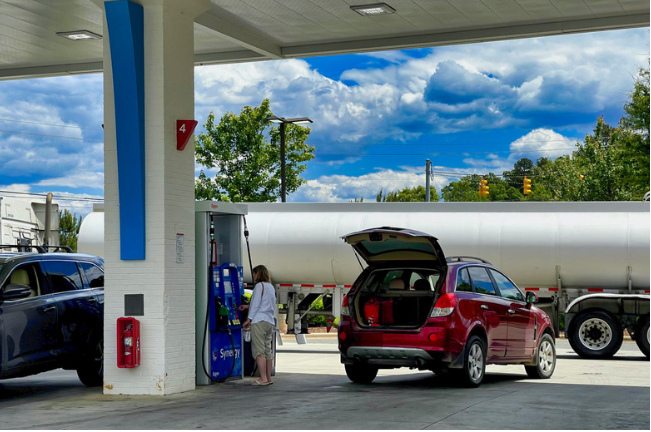
Amid the rising fuel prices that have hounded global economies, including our own, it is becoming more and more common for motorists to buy and store fuel at home when gas and diesel prices dip.
So, you may be wondering if it's safe to buy larger amounts of fuel and keep them in storage for some time. Whether you drive a gas-powered crossover like the Chevrolet Trailblazer or a diesel-fed SUV like the Isuzu mu-X, it's worth knowing how to store fuel safely if ever the need arises.
Storing gasoline or diesel at home safely

For the purposes of this guide, we're assuming you will be using a portable gas storage solution, such as a jerry can. That's the rectangular container with handles and a spout that commonly comes in orange, black, or other colors.
There are more ways to store fuel, including vehicle-specific accessories or an above-ground tank installed on your property. However, using a jerry can is one of the simplest and quickest ways to store fuel in a pinch. If you haven't got one, choose a high-quality product with a capacity that's to your liking.
Using recycled PET bottles is inadvisable, as gas and other fuels can degrade the plastic over time. It may also contaminate the fuel and possibly damage your engine if used. Besides, many gas stations may not allow you to purchase gas if you have a substandard container.
Once you have a suitable container, you may start filling up your container. If you're not at the pump yourself, remind the attendant to place the container on the floor before filling up. That is to avoid static electricity from causing a spark in the gas vapors. The fumes from a cup of gasoline contain the explosive power of about five pounds of dynamite, so it's best to go about it carefully.
When you've filled up to your liking, you may transport the fuel to your home, but do it quickly. Avoid storing unused gas in your car for long periods, as it's never safe and is a fire and explosion hazard. Unless you have an accessory specifically built to store gas inside or outside a vehicle, just don't take the risk.
Now that you've transported the fuel to your home, you should look for an appropriate place to store the gas, ideally outside your main living area. The area should offer protection from the elements, neither getting too cold nor too hot. An enclosed garage could be suitable, but make sure to provide the containers with adequate protection and isolation.
How long does gas last?

It's the big question—how long can you safely store gas at home without it going bad? It's relevant these days more than ever as fuel prices continue to skyrocket beyond anything we've seen before.
Typical gasoline goes bad after about 30 days, after which it begins to evaporate or degrade. The fuel components may also split apart, leaving you with what used to be gas but is now a heady mix of unusable chemicals.
However, that doesn't mean standard gas becomes unusable after 30 days. Your car may run on older gas, but don't expect performance to remain the same. At some point, the bad fuel can damage your engine and cost you more in the long run.
Many people use the "use and replace" method to store gas efficiently. It involves topping up a vehicle with fuel from one of the stored containers instead of directly from the pump. You would then need to refill the container at a gas station and repeat the cycle all over again. This method keeps your stored gas fresh while always keeping you with a steady supply. Once you get the hang of timing oil price rollbacks with your refueling habits, the savings could start pouring in.
Latest Features
-
The difference between wax and polish / Tips & Advice
Confused about whether your car needs a wax or polish? This article will guide you on what they are and what to choose for your car.
-
The 6 things every Ford Ranger must pass before it leaves the factory / Featured Article
Every Ford Ranger, from the base model to the Ranger Raptor, goes through a full inspection process before it leaves the factory. This includes six steps that make sure it’s ready to drive a...
-
Which GAC AION EV is best for your everyday lifestyle? / Featured Article
The GAC AION lineup has something for everyone, maybe you're after space, speed, or just a smooth city drive. Here's a quick breakdown of which model might work best for your day-to-day life...
Popular Articles
-
Cheapest cars under P700,000 in the Philippines
Jerome Tresvalles · Sep 02, 2024
-
First car or next car, the Ford EcoSport is a tough package to beat
Jun 18, 2021
-
Car Maintenance checklist and guide – here’s everything you need to know
Earl Lee · Jan 12, 2021
-
Most fuel efficient family cars in the Philippines
Bryan Aaron Rivera · Nov 27, 2020
-
2021 Geely Okavango — Everything you need to know
Joey Deriquito · Nov 19, 2020
-
Family cars in the Philippines with the biggest trunks
Sep 20, 2023
-
Head to head: Toyota Rush vs. Suzuki XL7
Joey Deriquito · Oct 28, 2020
-
Why oil changes are important for your car
Earl Lee · Nov 10, 2020
-
2021 Kia Stonic — What you need to know about it
Joey Deriquito · Oct 16, 2020
-
Top 7 tips for buying a used car in the Philippines
Joey Deriquito · Nov 26, 2020



